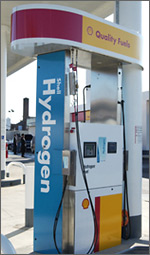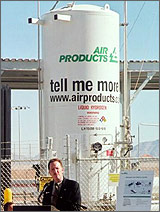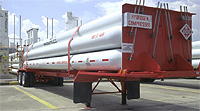President's Hydrogen Fuel Initiative

The Hydrogen Fuel Initiative aims to reverse America's growing dependence on foreign oil by developing the technology needed for commercially viable hydrogen-powered fuel cells.
"A simple chemical reaction between hydrogen and oxygen generates energy, which can be used to power a car producing only water, not exhaust fumes. With a new national commitment, our scientists and engineers will overcome obstacles to taking these cars from laboratory to showroom ... Join me in this important innovation to make our air significantly cleaner, and our country much less dependent on foreign sources of energy."
— President Bush, State of the Union Address, January 28, 2003
A Clean and Secure Energy Future

In his 2003 State of the Union Address, President Bush announced a $1.2 billion Hydrogen Fuel Initiative to reverse America's growing dependence on foreign oil by developing the technology needed for commercially viable hydrogen-powered fuel cells — a way to power cars, trucks, homes, and businesses that produces no pollution and no greenhouse gases. The initiative will dramatically improve America's energy security by significantly reducing the need for imported oil. At the same time, it is a key component of the President's clean air and climate change strategies.
President Bush's Budget Provides Strong Support for the President's Hydrogen Fuel Initiative
- The FY 2004 appropriation for hydrogen and fuel cell research and development through the Hydrogen Fuel Initiative was $157 million.
- The FY 2005 appropriation for hydrogen and fuel cell activities in support of the Hydrogen Fuel Initiative was $222 million.
- The FY 2006 appropriation for hydrogen and fuel cell activities in support of the Hydrogen Fuel Initiative is $232 million.
- The FY 2007 appropriation for hydrogen and fuel cell activities in support of the Hydrogen Fuel Initiative is $274 million.
- More information about the Hydrogen Fuel Initiative budget is available on the DOE Hydrogen Program Web site.
Why Hydrogen and Fuel Cells?
America's Energy Security Is Threatened by Our Dependence on Foreign Oil

- America currently imports 55 percent of the oil it consumes; that is expected to grow to 68 percent by 2025.
- Nearly all of our cars and trucks currently run on gasoline, and they are the main reason America imports so much oil. Two-thirds of the 20 million barrels of oil Americans use each day is used for transportation.
- Hydrogen has the highest energy content per unit of weight of any known fuel.
- Hydrogen can be produced from abundant domestic energy resources including fossil, nuclear, and renewable.
Hydrogen and Fuel Cells Are Key to a Clean Energy Future
- Vehicles are a significant source of air pollution in America's cities and urban corridors.
- When burned in an engine, hydrogen produces effectively zero emissions; when powering a fuel cell, its only by-product is pure water.
- Renewable- and nuclear-based hydrogen production technologies offer the promise of zero emissions. With proven carbon capture and storage technologies, hydrogen production using our Nation's abundant coal resources will also make a carbon emissions-free future possible.
Hydrogen, Like Any Other Fuel, Is Safe When Handled Properly

- Hydrogen has been used safely in chemical and metallurgical applications, the food industry, and the space program for many years.
- By their nature, all fuels have some degree of danger associated with them. Hydrogen is non-toxic and because it is much lighter than air, it dissipates rapidly when it is released, allowing for relatively rapid dispersal of the fuel in case of a leak.
- Some of hydrogen's properties require additional engineering controls to ensure its safe use by consumers.
About the President's Hydrogen Fuel Initiative
It Will Overcome Key Technical and Cost Barriers
- Lowering the cost of hydrogen: Currently, hydrogen is more expensive to produce than conventional gasoline. The President's Hydrogen Fuel Initiative seeks to lower that cost enough to make hydrogen cost-competitive with other fuels and technologies, and to advance the methods of producing hydrogen from renewable resources, nuclear energy, and coal (with carbon capture and sequestration).
- Creating effective hydrogen storage: Current hydrogen storage systems are inadequate for use in the wide range of vehicles that consumers demand. The President's Hydrogen Fuel Initiative supports the research and development needed to overcome the grand challenge for hydrogen storage: to store the amount of hydrogen required for a conventional driving range (>300 miles), within the vehicular constraints of weight, volume, efficiency, safety, and cost.
- Creating affordable hydrogen fuel cells: Currently, fuel cells are more expensive than internal combustion engines. The President's Hydrogen Fuel Initiative is working to reduce the cost and improve durability of fuel cells.
It Will Help Ensure America's Energy Independence
- Through the President's Hydrogen Fuel Initiative, the Federal government, automotive and energy industries, universities, national laboratories, and others are working together to overcome the technological and financial barriers to the successful development of commercially viable, emissions-free fuel cell vehicles that require no foreign oil.
Federal Support Can Accelerate Development
- Additional research and development is needed to meet consumer requirements and enable rapid commercialization so that hydrogen and fuel cell technologies can provide clean domestically-produced energy for transportation and other uses.
- The DOE Hydrogen Program has made significant progress toward achieving R&D goals. As of 2007, the Program has:
- Reduced the cost of producing hydrogen from natural gas from $5.00/gge in 2003 to $3.00/gge (2015 goal: $2.00/gge).
- Reduced high-volume cost of fuel cells from $275/kW in 2002 to $107/kW (2015 goal: $30/kW).
- Identified new materials with potential for high storage capacity (2015 goal: 300-mile range).
- 77 fuel cell vehicles and 12 hydrogen fueling stations demonstrated 53–58% fuel cell efficiency, 103- to 190-mile range, and 1350-hr durability (~40,000 miles) in 2007 (2015 goals: 60%, 300 miles, 5000 hours).
For more information on the President's initiatives, please visit the White House Web site.

















